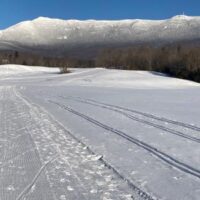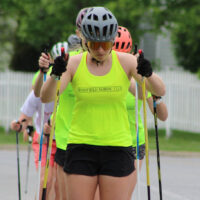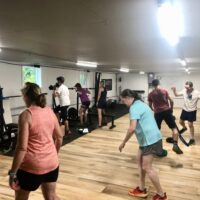The psychology of a big challenge can be heavily affected by the seasons. In summertime, far removed from the pressure (self-imposed or otherwise) of race results and ranking lists, arduous workouts and epic challenges are coveted. Coaches are often spending the warmer months preaching the value of balanced workouts and controlled paces, and worrying about the dangers of pushing too hard before the “important” races happen.
When your biggest metric is personal improvement, when there’s no spot on a trip or championship on the line, and when the experience is shared with friends and teammates, the toughest obstacles can be conquered with relative ease:
Rollerski 100 kilometers? No problem. What about rollerskiing from 6am to 6pm? The entirety of daylight?
Uphill run test straight to the top of Bolton? The team won’t settle for that…they are asking how many extra intervals they can do after in order to get more intensity.
Mount Washington? That’s just one mountain. Presidential Range? Lame…”That’s what they did at Mountain Camp back in like 2018. It’s Pemi Loop or nothing.”

Liam and Gabe attacking one of many hills
The racecourses in Lake Placid are the toughest in the country. At least, they are the toughest racecourses I have ever seen or skied, and I have certainly seen my fair share of courses and venues across America in the last 20 years. The hills are steep, but they are also extremely wide. They skew your perception of speed and distance. If you’ve ever driven through South Dakota, you know the 80mph speed limit still feels like a crawl when there’s nothing on either side of you as far as the eye can see. In Lake Placid, skiing up a relentless 20% grade with a South Dakotan field of vision is not easy. When you turn the corner and find more hill and not a respite like other ski courses, the challenge doesn’t double: it multiplies.
Sounds like a big challenge, similar to an epic summer endeavor like the Bolton uphill test or the 100km rollerski, right?
The problem is, there’s more strings attached and more to overanalyze. This race has points generated from it. Ranking lists will be altered by the results of these races. College coaches are here and they might be watching. So-and-so hasn’t beaten me this year, but what if they do today?
All of a sudden, a single competition that is actually less daunting than the insane workouts our team can concoct for themselves. The FIS certification for the 3.5km course shows 140 meters of climbing. For a 2-lap course that’s 280 meters/918 feet. Less vertical than the Bolton uphill run test, and this one has some downhills involved! About 23-27 minutes to complete…that’s over 6 hours shorter than the 100km rollerski!
The key is confidence. We can achieve all of these great feats in the other months, so what’s to stop us bringing our best and fastest selves to the race course when it’s snow on the ground instead of pavement or dirt? The more we race this winter, the more we’ll keep exploring that psychology. This past weekend we had some amazing performances and great personal breakthroughs.
First up was the women’s race with Charlotte having her best distance race on the Eastern Cup and making the most of her awesome running season fitness (competing all the way through Nationals in Oregon). Then it was onto highlights like Farmer taking a break from his nearly dominant HS racing season to hit up the New York trails, the 7.5k was additionally challenging with tricky snow and wax to add to the mix. In the U16 boys race our Middlebury-area contingent of Jorgen and Gabe skied great, and James had his best race yet as the 5th American (we were joined by many strong Canadian racers from multiple northern teams this weekend). But of the whole field there was nobody that was going to match Sylas’ classic technique on the climbs:

But a highlight of the season so far, and possibly a highlight of MNC as a club, was the U16 girls race. In a 5km classic race I have never been so convinced that we had swept the podium before I even looked at the results. I was cheering and taking video at the highest point of the course, after a brutal series of the most strung-together climbs possible for five kilometers of racing.
Skiers were plunked onto their poles, shuffling to survive, herringboning to make it home, slipping in shambles, and…you get it.
But then one by one they came around the corner and up the rise. First Mia, striding quickly and powerfully upright. Then Astrid, poling up the gradual climb and seamlessly transitioning into a dynamic gliding stride. Then Acadia kicking like she was at the start of a sprint race and then double poling after deciding that hill was nothing to her.
This was obvious. Those three were going to be 1st, 2nd, and 3rd. I couldn’t quite parse out from what I saw just which order they’d end up in, but their skiing was on a completely different level than everyone else.
Turns out they all crossed the line and BOOM. Acadia 1st, Astrid 2nd, Mia 3rd. It also turns out I was right about not being able to tell the exact order from that one section of trail: all three were only separated by 9 seconds!
I didn’t see the results right away, but others had. As I skied back down the winding trail to the stadium the various parents and friends along the trail were all pumping their fists in the air and shouting stuff like “did you see that?!” and I knew.
…But there is a twist to the happy ending. Remember that little mention of the Canadians earlier in this post? Well, there were some very speedy foreign competitors in this race who, because they don’t have traditional NENSA licenses, were starting behind all of the seeded competitors. So just as I was getting ready to approach the stadium and congratulate our sweep-crew, I saw two skiers in race suits I’d never seen before absolutely gunning-it toward the finish.
“Uh oh” I said, probably out loud.
And just like that, a true sweep was foiled. For NENSA points purposes, the Canadians don’t count, but they were in the race and fair is fair! So it was bittersweet, but in a great motivational way. The first thing I told that trio when I saw them was how awesome they were. But the next thing I said was how it was a great spot to be in: knowing that you can pull off a sweep of your main competition when it all goes right, but also knowing that there’s always others out there ready to push you to strive even harder. And of course, after the main podium with Acadia in 3rd (her first podium!) we did jump up for an “American Podium Sweep” photo:

That’s what we call an M-N-C-1-2-3!
Day two brought an opposite style of action, with skate sprints of furious uphill hop-skating and tactical high-speed descents. In the open qualifier it was a birthday bash for Niko who was the talk of the coaches radio chatter. Kristen on the hill buzzed in with a “Niko looks absolutely insane on this uphill” after which Sara and I saw in person as he beautifully tuck-skated the final gradual descent and ballet-danced his skis around the final corner into the finish. Niko has this thing where he tried to do every downhill on one foot at practice, turns included. You can’t say it wasn’t effective here, as his mix of balance and power propelled him to an astounding 6th place overall in a qualifier full of stacked Canadian pro skiers and collegiate athletes.
He was joined in the open heats by Anders (9) and Jonah (12). Niko skied the hill amazingly once again in his heat in the lead, but unfortunately was in the perfect position for the opposition to catch his draft on a long descent. Still, he battled to 3rd in his heat which is incredible for a U18 in this field and multiple steps ahead of the last sprint in Craftsbury where he was clinging onto the pack into the finish.
Both in the same quarterfinal, Anders and Jonah battled 4 Canadians. Jonah and Anders both advanced marking Jonah’s first time advancing past the quarters in an open heat. In the semis, Jonah’s 3rd place finish netted him 7th overall in the whole Eastern Cup, and first U18. With Niko finishing 13th, that earned them both a trip to the podium!

Although he just barely missed the open heats in 33rd, Lorenzo used the same tactic in each of his heats to make it all the way to the final and finish as 3rd American. Although he could charge up the hill like nobody’s business, he stayed calm and put himself in the advantageous position of always being 5-7 feet behind first place in order to rocket right around them on the descent. In the final things got a little more strung-out, but Lorenzo went from never having even made the Junior heats before, to skiing through to the final and coming close to winning it all!
The final races of the day were the U16 heats, with a shoutout here for Isaiah who had his strongest result yet in the qualifier of 10th. James and Jorgen also were slated to race it out, but things came to an unfortunate early end for Isaiah and James: another skier moved left and Isaiah was tripped-up, and right behind him was James. The two collided in an unavoidable situation and had to try to make up ground that was never fully theirs. It was a great motivator if nothing else!
In the women’s U16 heats it was Astrid (1), Acadia (4) and Mia (7) all finishing strong in their first heat to be sharing the final together. 3 of them in the final heat…was a sweep possible again? We talked about tactics…they could let another team’s skier lead and try to get the draft, or they could hit the gas from the gun and try to drop everyone else. The second option was riskier, but more intriguing and that was agreed on.
The only thing was, the gas tanks weren’t quite full after so much racing over the weekend, and Acadia was stuck with a far outside lane that made navigating the heat harder than usual. So, the sweep was relegated to day 1 but the excitement remains!
At a coaching clinic few years ago someone mentioned that their favorite saying was “challenge is a choice” and that has stuck with me. Sometimes challenges can be easier to dig into, especially when they are far removed from racing season and the goals we all spend months thinking about. In the heart of the season those goals loom larger, and even small challenges can seem too daunting to attempt. But in both cases, those challenges are a choice. If we can remember all the big challenges we’ve willingly embraced, what’s to fear about a few other ones that come our way?

See you in March, Lake Placid!




Comments are closed.